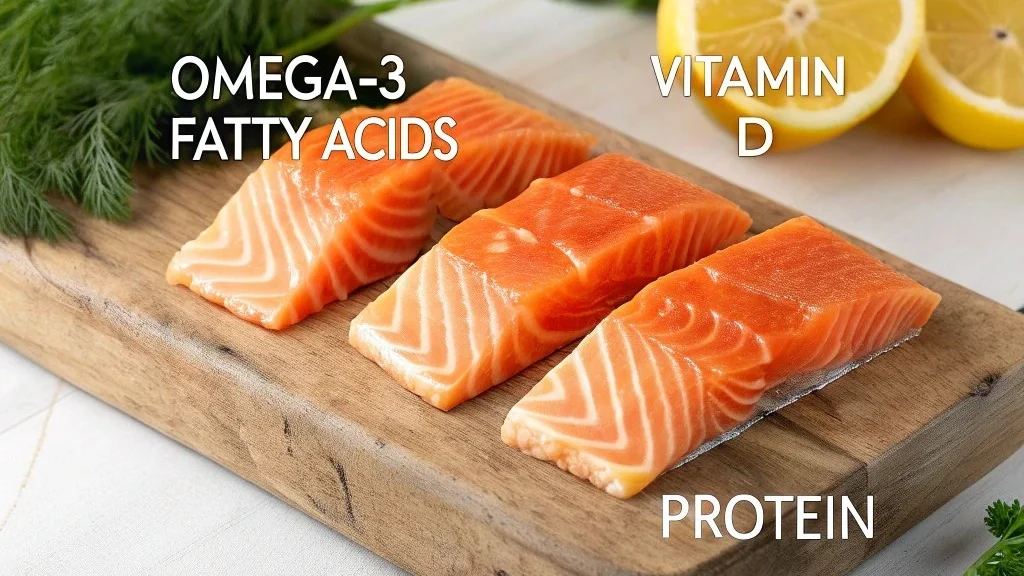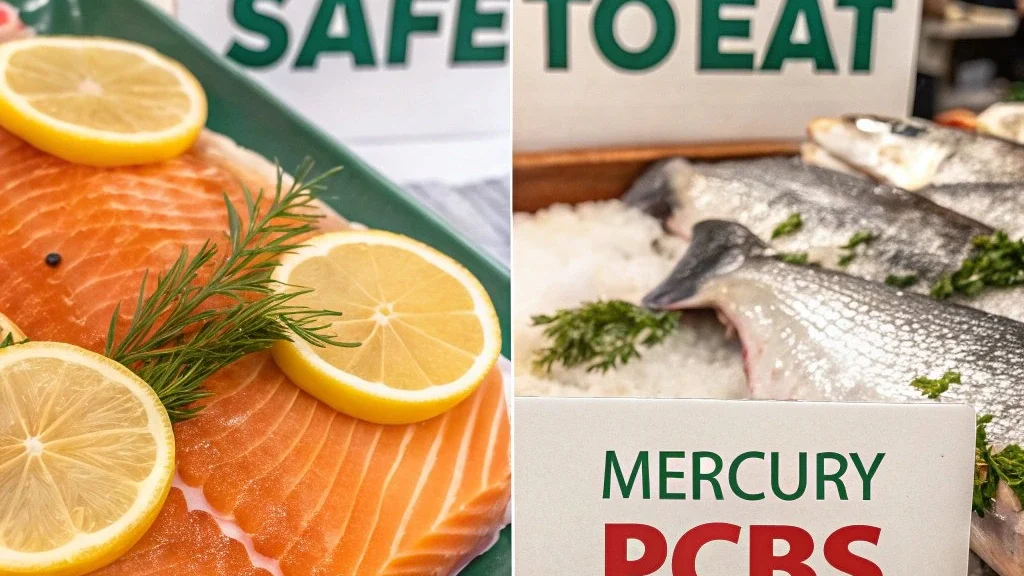Salmon has earned its reputation as a superfood, thanks to its rich nutritional profile and numerous health benefits. But as with any food, moderation is key. So, how often should you eat salmon to enjoy its benefits without overdoing it?
In this guide, we’ll explore the recommended frequency for consuming salmon, its nutritional advantages, and potential risks. You’ll also learn tips for incorporating this delicious and healthy fish into your diet in safe and sustainable ways.
Table of Contents

Nutritional Benefits of Salmon
Salmon is packed with nutrients that make it a standout choice for a healthy diet. From heart-healthy fats to essential vitamins and minerals, here are the top reasons why salmon deserves a place on your plate.
1. Omega-3 Fatty Acids
Salmon is one of the best natural sources of omega-3 fatty acids, which are essential for overall health. These healthy fats provide numerous benefits:
- Heart Health: Omega-3s reduce inflammation, lower blood pressure, and improve cholesterol levels.
- Brain Function: These fats support cognitive function and may reduce the risk of neurodegenerative diseases.
- Joint Health: Omega-3s can ease symptoms of arthritis by reducing joint stiffness and pain.
Tip: Wild salmon contains higher levels of omega-3s compared to farmed salmon, so choose accordingly based on your nutritional needs.
2. High-Quality Protein
Protein is vital for building and repairing tissues, and salmon delivers it in abundance.
- Why It Matters: A single serving of salmon (about 3–4 ounces) contains approximately 22–25 grams of protein, making it a great option for muscle health and weight management.
- Bonus: Unlike some other protein sources, salmon is naturally low in saturated fat.
Quick Meal Idea: Add grilled salmon to a leafy green salad for a protein-packed lunch.
3. Essential Vitamins and Minerals
Salmon is rich in several vitamins and minerals that support overall health:
- Vitamin D: Crucial for bone health and immune function. Salmon is one of the few natural dietary sources of this vitamin.
- Vitamin B12: Supports energy production and neurological health.
- Selenium: Acts as a powerful antioxidant, protecting cells from damage.
- Potassium: Helps regulate blood pressure and balance electrolytes.
Fun Fact: A 3-ounce serving of salmon provides more than half of the recommended daily intake of vitamin D.
By including salmon in your diet, you can enjoy these powerful health benefits while adding variety to your meals. In the next section, we’ll discuss how often you should eat salmon based on general recommendations and individual health goals.
Recommended Frequency of Eating Salmon
Including salmon in your diet can provide a wealth of health benefits, but how often should you eat it to maximize those benefits without overdoing it? Here’s a breakdown of the recommended frequency for different groups and health goals.
1. General Recommendations
- For Adults: Eating salmon 2–3 times per week is considered optimal. This amounts to about 8–12 ounces per week, providing enough omega-3 fatty acids and protein to support overall health.
- For Children: Serve smaller portions of salmon 1–2 times per week to support growth and brain development.
- For Pregnant Women: Pregnant and breastfeeding women should aim for 2–3 servings of low-mercury seafood, such as salmon, each week. The omega-3s in salmon play a vital role in fetal brain and eye development.
Note: Always consult a healthcare professional if you have specific dietary restrictions or health conditions.
2. Balancing Omega-6 and Omega-3 Intake
Modern diets often include high levels of omega-6 fatty acids from processed foods and vegetable oils. Eating salmon helps restore the balance between omega-6 and omega-3 fatty acids, which reduces inflammation and promotes better overall health.
- Pro Tip: Pair salmon with other omega-3-rich foods like walnuts, chia seeds, or flaxseeds for an added nutritional boost.
3. Frequency Based on Health Goals
- Heart Health: For cardiovascular benefits, aim for 2–3 servings of fatty fish, such as salmon, per week as recommended by the American Heart Association.
- Brain Function: Regular consumption of salmon (at least twice a week) may help improve memory and cognitive function.
- Weight Loss: Salmon is a high-protein, low-calorie option that keeps you full longer. Incorporate it into your diet 2–3 times per week to aid in weight management.
Weekly Planner for Salmon Meals
If you’re unsure how to include salmon in your weekly routine, here’s a simple example:
- Monday Dinner: Baked salmon with roasted vegetables.
- Wednesday Lunch: Salmon salad with mixed greens.
- Friday Dinner: Grilled salmon tacos with avocado and salsa.
By following these guidelines, you can enjoy the benefits of salmon without exceeding recommended limits. In the next section, we’ll address the potential risks of overconsumption and how to make safe and sustainable choices.

Risks of Eating Salmon Too Often
While salmon is a nutrient-dense and healthy food, eating it too frequently can have drawbacks. It’s essential to balance your intake to enjoy the benefits while minimizing potential risks.
1. Mercury and Contaminants
Like most fish, salmon may contain trace amounts of mercury and other environmental contaminants, such as polychlorinated biphenyls (PCBs). These toxins can accumulate in your body if consumed in excessive amounts.
- Farmed Salmon vs. Wild Salmon:
- Farmed salmon may have higher levels of contaminants due to their feed and farming practices.
- Wild-caught salmon generally contains lower toxin levels but may still have some exposure.
- How to Mitigate Risk: Choose high-quality salmon from reputable sources, and stick to the recommended 2–3 servings per week.
2. Imbalanced Nutritional Intake
Although salmon is healthy, relying too heavily on it can limit the variety in your diet. A diverse diet ensures that you receive all the nutrients your body needs.
- Pro Tip: Balance your weekly seafood intake by including other options like mackerel, sardines, or shellfish.
3. Environmental Concerns
Overfishing and unsustainable farming practices can harm marine ecosystems. Consuming too much salmon can contribute to these issues if the fish is not sustainably sourced.
- How to Make Eco-Friendly Choices:
- Look for labels like “MSC Certified” (Marine Stewardship Council) or “Sustainably Sourced.”
- Opt for wild-caught Alaskan salmon, which is known for sustainable fishing practices.
4. Omega-3 Overload
Although omega-3s are beneficial, consuming extremely high amounts can thin the blood, potentially increasing the risk of bleeding in certain individuals. This is especially a concern if you’re taking blood-thinning medications.
- Consult Your Doctor: If you have a medical condition or take medication, seek guidance on safe salmon consumption levels.
Balancing Benefits and Risks
By adhering to recommended serving sizes and sourcing your salmon responsibly, you can enjoy its health benefits without significant risks. In the next section, we’ll discuss practical tips for incorporating salmon into your diet safely and deliciously.

Tips for Including Salmon in Your Diet
Incorporating salmon into your diet can be both enjoyable and easy. By choosing diverse recipes and sustainable options, you can make the most of this nutritious fish. Whether you’re looking for a quick meal or a gourmet dish, finding creative ways to eat salmon regularly can enhance both your health and your culinary experience.
1. Explore Creative Meal Ideas
Salmon is incredibly versatile and works well in a variety of dishes. Whether you prefer it grilled, baked, or raw, there are endless ways to eat salmon without getting bored.
For Breakfast:
- Smoked salmon on whole-grain toast with avocado and a sprinkle of lemon juice.
- Salmon and vegetable omelet for a protein-packed start to your day.
For Lunch:
- A fresh salmon salad with mixed greens, cherry tomatoes, and a light vinaigrette.
- Salmon sushi rolls or poke bowls for a flavorful midday meal.
For Dinner:
- Grilled salmon with a side of roasted vegetables and quinoa.
- Baked salmon tacos with avocado salsa.
No matter the time of day, there’s always a delicious way to eat salmon while keeping meals balanced and flavorful.
2. Batch Cook and Meal Prep
One of the easiest ways to eat salmon more often is to prepare it in advance. Cooking multiple fillets at once allows you to use them throughout the week in various dishes.
Meal Prep Tip: Grill or bake a few fillets and store them in an airtight container in the fridge. Use them in salads, sandwiches, or rice bowls to save time while ensuring you always have a healthy protein option available.
3. Choose Sustainable Options
If you want to eat salmon regularly, choosing sustainable sources is key. Supporting responsible seafood practices helps protect the environment and ensures the best quality fish for your meals.
- Look for Labels: Choose products marked with “MSC Certified” or “Sustainably Farmed.”
- Go Wild: Wild-caught Alaskan salmon is a highly sustainable choice with lower contaminant levels.
By selecting high-quality, sustainable fish, you can enjoy eating salmon guilt-free while supporting ocean-friendly practices.
4. Pair Salmon with Complementary Ingredients
Salmon pairs well with a wide range of ingredients that enhance its flavor and nutritional profile:
- Healthy Fats: Avocado, olive oil, and nuts add richness and omega-3s.
- Citrus: Lemon and orange slices brighten up the flavor.
- Herbs and Spices: Dill, parsley, garlic, and paprika create bold tastes.
- Grains and Vegetables: Quinoa, sweet potatoes, asparagus, and broccoli complement salmon beautifully.
Pairing the right ingredients makes it even easier to eat salmon in new and exciting ways while boosting its nutritional benefits.
5. Try New Recipes
Experimenting with different cooking techniques keeps your meals interesting. Here are a few ways to eat salmon with variety:
- Pan-Seared Salmon: Create a crispy skin and a tender interior.
- Poached Salmon: Cook gently in broth or water for a delicate flavor.
- Air-Fried Salmon: Achieve a crispy texture with minimal oil.
With so many preparation methods, you’ll never run out of ways to eat salmon and keep your meals exciting.
6. Balance Salmon with Other Protein Sources
While salmon is an excellent protein source, maintaining variety in your diet is essential. Incorporating lean meats, plant-based proteins, and other seafood ensures a well-rounded nutritional intake. Even though eating salmon is incredibly beneficial, mixing it with different protein sources can help you maintain a diverse and balanced diet.
By applying these tips, you can eat salmon in delicious and nutritious ways throughout the week. Up next, we’ll answer common questions about salmon consumption to provide even more clarity on how to include it in your diet.
FAQs About Eating Salmon
1. How often should I eat salmon?
You can enjoy salmon 2–3 times a week, which provides 8–12 ounces of this nutritious fish. This frequency supports heart health, brain function, and overall wellness without the risks of overconsumption. If you’re curious about how to cook salmon perfectly, check out How Long Should You Cook Salmon? for expert tips on timing.
2. Should I eat salmon skin?
Yes, salmon skin is edible and packed with nutrients, including omega-3 fatty acids and protein. Many enjoy the crispy texture of cooked salmon skin. However, ensure it’s sourced from clean waters to minimize contaminants. For more insights, read Do You Eat Salmon Skin? 10 Surprising Facts About Its Benefits and Risks.
3. How do I know when salmon is done?
Determining if salmon is done involves checking for visual, textural, and temperature cues. Cooked salmon is opaque, flakes easily, and reaches an internal temperature of 145°F (63°C). For a detailed guide, explore How to Tell When Salmon Is Done?.
4. Are sushi poke bowls healthy?
Yes, poke bowls are generally healthy, especially when they include fresh salmon, vegetables, and whole grains. They offer a balanced mix of protein, healthy fats, and fiber. Learn more about their nutritional benefits in Are Sushi Poke Bowls Healthy? A Complete Guide to Their Nutrition and Benefits.
5. What can I do with leftover salmon?
Leftover salmon is versatile and can be transformed into tasty dishes. A classic option is salmon patties, which are easy to make and perfect for quick meals. Try this Old-Fashioned Salmon Patties Recipe: A Timeless Delight to Savor for a delicious twist.
Conclusion
Salmon is a superfood that offers numerous health benefits, from supporting heart health to enhancing brain function. However, knowing how often you should eat salmon is essential to balance its advantages with potential risks. Sticking to 2–3 servings per week ensures you receive its nutrients without overexposure to contaminants.
When preparing salmon, experiment with its versatility by trying new recipes or learning more about cooking techniques. For tips on achieving perfectly cooked salmon, read How Long Should You Cook Salmon? and How to Tell When Salmon Is Done?. If you enjoy the crispy texture and added nutrition, don’t forget to try salmon skin—learn more in Do You Eat Salmon Skin? 10 Surprising Facts About Its Benefits and Risks.
For sushi and poke lovers, incorporate salmon into a balanced poke bowl. Learn how to make healthier choices in Are Sushi Poke Bowls Healthy? A Complete Guide to Their Nutrition and Benefits. And if you have leftovers, don’t let them go to waste—turn them into delicious patties with Old-Fashioned Salmon Patties Recipe: A Timeless Delight to Savor.
By balancing frequency, exploring sustainable options, and trying new dishes, you can fully enjoy the incredible versatility and benefits of salmon in your diet.
